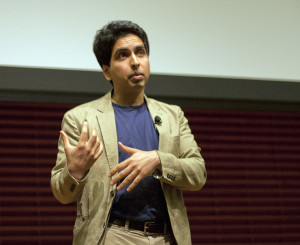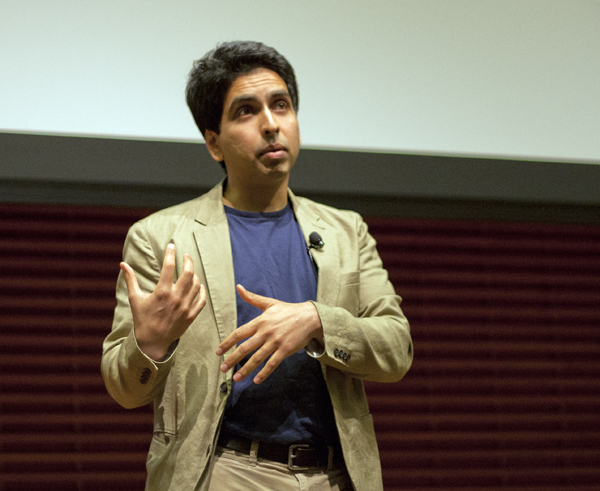This is the second in a series of two articles. The first article highlighted the challenges, according to Sal Khan, that higher education faces. This one outlines the solutions he envisions.
U.S. students sit on nearly a trillion dollars of debt, 80 percent of American adults do not feel college is worth its price and the cost of higher education continues to rise. Yet Salman Khan, founder of education platform Khan Academy, seems curiously energized.
In an interview with The Daily, Khan discussed what he would do if he were the secretary of education, why GPAs don’t work and how Stanford may be the testing ground for the change education needs.

An alternative to grades
“Everything takes exactly four years to learn,” Khan said. “Whether it’s a field that got invented in the 1970s like computer science or whether you’re learning art history or the classics, they all magically somehow take exactly four years to learn.”
“Not learn,” he corrected himself. “Sit through.”
Khan sees a number of inefficiencies in the way in which learning is structured at universities and how skills and abilities are measured.
“What I get to in the book is a competency-based model,” he said, outlining an alternative to our current system of grades for classes. He pointed to the grade point average (GPA), the aggregate of grades that tells others — especially future employers — little about what we actually know, as an example.
“Credentials should not be this weird snapshot of where you are at that moment that have no meaning later on and give you no incentive to improve,” he said. “They should be: What is your knowledge state? What do you know? And what do you not know?”
The design of a future system of competency assessments is murky because of the number of stakeholders involved and the untested alternatives.
“It could be a very specialized: As in, ‘Do you understand how to use that product?’ Or it could be very meta-level: how well someone writes, how good their logical and thinking skills are, how they communicate with each other,” he said.
The crux of any future system would be that “it cuts to the chase of everyone’s needs and it frees the mindset of people so that they can prepare in any way.”
Khan believes that a freer competency assessment model would allow people to receive vastly different educations and still remain competitive for the same jobs and opportunities, allowing learners greater choice and freedom.
“We’re thinking about a competency-based world, and in our mind there’s no such thing as a K-12 competency or a higher educational competency or a vocational competency,” he said.
“There are just a bunch of competencies and people will choose what matters to them, both on what they want to get and in terms of when they hire people or employ people,” he said.
He does believe that such a system would not come under the purview of the private sector.
“I know third-party companies want to enter that space. I think history shows us that there is not one credible credential that has come from the for-profit reality, and that is because the for-profit reality is inherently motivated to maximize the level of people that take it,” he said.
“If I were secretary of education, that’s all I would work on for four years,” he said. “Instead of billions here and billions there, I would spend a hundred million and create a battery of assessments.”
“They can be very rigorous, more rigorous than anything that ever happens in a college classroom, that especially measures skills that are highly important,” he said.
Learning from the ancients
“The ancient universities was not as based on how many credit hours you’re taking and whether you’ve completed your credit hours,” Khan said. “The ancient universities were much more interested in customized, personalized learning. … Where you have a mentor and where you’re learning at your own pace.”
He sees these historical learning systems as possible models for future schools and places, or platforms, of education.
In particular, Khan Academy focuses on the student-to-teacher ratio, or more accurately, its elimination.
“Nowadays, there is so much emphasis on student-to-teacher ratio. We at The Khan Academy do not believe in this multiple — we believe in optimizing student-to-valuable-time-with-teacher ratio, or even more importantly, student-to-valuable-time-with-other-human-beings ratio,” Khan said last February at an event at the Graduate School of Business. “A one-size-fits-all lecture is not the way to go about education.”
Khan’s commitment to the flipped classroom model, where students come to class for practical instruction after viewing course content online at their own pace and convenience, is a natural product of his pedagogic leanings. And he is keen to see this model implemented in schools and universities.
The Khan Academy is translating conversation to commitment with its partnership with the Stanford School of Medicine and its Stanford Medicine Interactive Learning Initiatives, which is implementing Khan Academy lectures in classes.
“The medical school’s kind of been going in that direction anyways, where lectures are recorded and only around 20 percent of students come to class. … Their thinking is exactly that: ‘Let’s take lectures off the table and if people come to class, let’s make it interactive,’” he said.
The Khan Academy also collaborates with the Stanford-based massive open online course (MOOC) platform Class2Go on designing online problem sets, and Khan says he is certain more partnerships are soon to come.
‘We cannot leave things as they are’
“All of Stanford’s down the road [from Khan Academy HQ in Mountain View], so we have more interaction with Stanford than anyone,” Khan said, which could mean a number of experiments at the Farm that are the basis for future educational models and processes.
But the real innovation lies in how independently and creatively the 36 people in the Khan Academy’s office and other pioneers like them around the world envision what education could be like, freeing themselves from traditional models and paradigms, according to Khan.
“Even with some of these other MOOCs, they’re still kind of tied to the traditional course model,” Khan said. “They’re still kind of like, ‘Let’s virtualize the traditional course model,’ but I think that’s a dangerous thing, because you’re not trying to virtualize the college experience.”
Through the position he has quickly gained in the educational sector, Khan has the ability to reengineer the educational experience. Khan Academy boasts 216,482,703 lessons delivered and Time Magazine’s 2012 list of the world’s most influential people entry on Sal Khan was written by Bill Gates.
As he closes his book, he warns of the cost of inaction in this sphere, but ends optimistically, with a hope that technology and new methods will help address the challenges we face in education.
“The one thing we cannot do is leave things as they are,” he wrote. “The cost of inaction is unconscionably high, and it is counted out not in dollars or euros or rupees but in human destinies.”
“Still, as both an engineer and a stubborn optimist, I believe that where there are problems, there are also solutions.”
